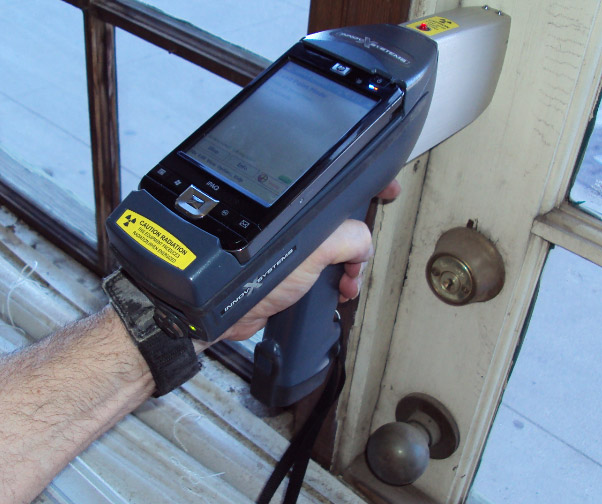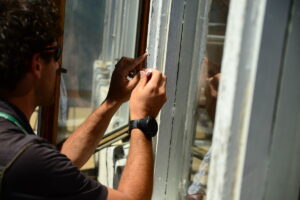If you’ve recently been issued a Violation 623 in Manhattan, you’re probably wondering if you could just scrape off the paint and call it a day. Only if it were that simple.
HPD has very specific ideas about how lead testing should be done. One of which includes XRF testing.
Requirements for XRF Lead Testing in NYC are getting much stricter. Here’s what you need to know about XRF testing and why you need it to clear a Violation 623.
What is XRF Testing?
XRF stands for X-Ray Fluorescence, which is a method to detect lead in paint. With the help of a high-tech scanner, this method allows you to see through layers of paint to detect lead underneath, without having to scrape or damage your walls.
Unlike traditional paint chip testing, XRF testing is non-destructive. You simply have to hold a handheld device at your painted surfaces, pull the trigger, and within seconds, you get a reading of lead levels.
No scraping, no lab wait times, no hoping you collected the right sample from the right spot.
The technology works by shooting X-rays at paint layers. Different elements absorb and emit X-rays in unique patterns. The XRF device reads these patterns and can tell you not just whether lead is present, but how much is there. It’s typically measured in milligrams per square centimeter.
Why is XRF Testing the Gold Standard?
HPD prefers XRF testing for a couple of reasons. These include:
Accuracy and Reliability
XRF testing provides immediate, quantitative results. There’s no gray area. You get exact measurements that either meet safety thresholds or don’t. This eliminates a lot of the ambiguity that comes with traditional testing methods.
Comprehensive Coverage
With paint chip testing, you might miss lead-containing layers underneath newer paint. XRF can detect lead through multiple layers of paint, giving a more complete picture of what you’re dealing with.
Documentation Standards
XRF test results come with detailed reports that include exact measurements, GPS coordinates of test locations, and photographs. This level of documentation is exactly what HPD wants to see when you’re certifying violation corrections.
Quality Control
XRF devices require regular calibration and certified operators. This built-in quality control gives HPD confidence in the results, which translates to faster approval of your violation certifications.
Also Read: What is an HPD Lead Violation, and How Does It Affect Property Owners?
Step-by-Step Guide to Using XRF Testing to Clear Violation 623
When you’ve been issued a Violation 623 in Manhattan, it’s important that you prove to HPD that you’ve addressed all lead paint hazards properly. Here’s what the process typically looks like:
Step 1. Initial Assessment
XRF testing identifies exactly where lead paint is present and at what levels. This gives you a clear scope of work. This way, you know exactly what needs to be addressed and what doesn’t.
Step 2. Work Planning
Based on the XRF results you get, you can develop a targeted remediation plan with a professional. Areas with high lead readings usually need full abatement, while areas with lower readings might require encapsulation or other treatments.
Step 3. Clearance Testing
After the remediation work is wrapped up, a follow-up XRF testing is required to check whether or not lead levels are now below safety thresholds. This clearance documentation is crucial for certifying violation correction to HPD.
Step 4. Long-term Documentation
XRF test results create a permanent record of lead paint locations and levels. This documentation helps with future tenant turnovers and can prevent additional violations.
Financial Consequences of Inadequate Lead Testing Documentation
What happens if you clear a Violation 623 without proper XRF documentation?
- You’re at risk of rejected certifications. HPD increasingly rejects violation certifications that don’t include proper testing documentation. When your certification is rejected, you’re still facing daily penalties while you scramble to get proper testing done.
- In case of false certification, you’ll be fined. HPD typically keeps this fine at around $1,000 to $3,000, on top of the original violation fine.
- False certifications also lead to re-inspection fees. False certification inspection fees cost $100 for each re-inspection when HPD finds violations haven’t been properly corrected. These fees add up quickly when you’re cycling through rejected certifications.
- You’re under HPD’s scrutiny. False certifications may result in future certifications not being deemed compliant without an inspection attempt.
XRF Lead Testing for HPD Compliance
Clearing a Violation 623 successfully requires more than just good intentions. You need to make sure you’ve got the right documentation.
XRF testing provides the accuracy, documentation, and reliability that HPD demands for violation clearance. While the upfront costs might seem quite a bit, they’re minimal compared to the financial exposure of ongoing violations, rejected certifications, and daily penalties.
When you need reliable, professional XRF lead testing to clear Violations 623 in Manhattan, Manhattan Lead offers XRF Lead Testing in NYC designed for HPD compliance.
Our EPA-certified technicians understand the specific documentation requirements for clearing lead paint violations and work efficiently to help you resolve compliance issues quickly.
Don’t let inadequate testing documentation keep your violations open and your penalties mounting! Contact us today.




